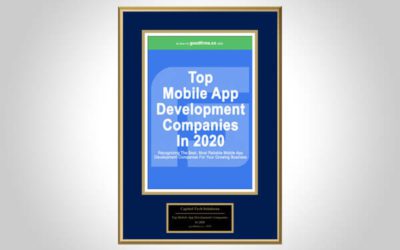A guide to kickstart your next Capitol Tech Solutions Software Development Project
Everything you need to know about preparing a Scope of Work to get your next software development project underway
At Capitol Tech Solutions, we use a metaphor that compares software development projects to remodeling homes. Before hiring contractors, a person must consult existing architectural plans and bring the house up to code.
Software developers, like contractors, can give a rough cost estimate. Still, they can’t provide an accurate price tag until the architecture review is complete and the work template is defined.
Our Sacramento-based web design and software development teams need to understand the nature of work, your expectations, requirements, and the users who will benefit from the finished product.
You want to develop documentation when there’s enough benefit for you to do that. If there is a lot of contexts, you better document that so when you present it, you can get what you want
In this blog post, Capitol Tech Solutions will provide an in-depth overview of:
- What a Scope of Work, also known as a Statement of Work, entails
- Why you should have one before embarking on your next upgrade
- How to optimize your Scope of Work for the CTS software development team
What is a Scope of Work? Is it a Statement of Work?
A Scope of Work is a vital agreement that details objectives that prevent ambiguity and miscommunication during the design of your software development project. It also keeps you informed and reassured at every stage — from conceptualization to Go Live.
Scope of Work (SOW) or Statement of Work (SOW) outlines project management, tasks, deliverables, phases, milestones, schedule, payment, responsibilities, and more. In this article, SOW refers to Scope of Work.
The SOW should be the first document you create after gathering information about your operational needs, determining where you’d like to improve, and contracting a vendor to implement your ideas.
Why is an SOW Important?
An SOW provides a layer of detail that cost estimates and project plans don’t typically include, describing what will be a deliverable, what won’t be a deliverable, and in what amount of time.
There is a considerable amount of work involved in creating an SOW. Still, it’ll serve as a good exercise in the project management process, allowing you to adjust your estimate, timeline and pin down proposed items from previous internal meetings and discussions.
The SOW documents will be the client (you) and Capitol Tech Solutions’ guidebook, determining what is in scope and out of scope for the project ahead — allowing you to track the performance and progress throughout the project.
The Capitol Tech Solutions’ Approach to Project Management
When software developers at CTS write an SOW for our clients, it entails:
- Overview
- Scope of Work Statement
- User Types
- Functionality
- Workflows & Processes
- Databases Attributes
- UI Frameworks
- Software Requirements
- Future Phased Development
Let’s break down each of these components so you can optimize your SOWs for CTS:
Overview
An overview will explain your organization’s goals for an application, describing what’s already in place and how you want it to improve.
Here is where you identify the date and location of drafting the SOW to avoid any credibility concerns later, should they arise in the process.
Identify related project manager(s), business development manager(s), and give us an idea of your budget, including if there will be a contingency amount and an allocation for support and maintenance of the application after Go Live.
Scope of Work Statement
The scope of work statement defines deliverables and outlines how Capitol Tech Solutions will complete the project for you.
Here is where you identify your ideal timeline for the project. What deliverables are you expecting? What tasks will be completed by CTS, and which will your organization take charge of?
What are the phases of individual and grouped tasks? What are the project’s milestones?
Answering these questions in detail will provide both you and us with a 30,000-foot view of the project.
User Types
When embarking on an application build, you need to outline the intended users internally and externally.
Describe each user in detail and how you envision they will interact with the application — from client to entry-level personnel to management to executives.
This will create personas and user stories that directly inform the workflows and processes that our team will articulate in the UI Framework.
Workflows & Processes
To optimize the project for the CTS team, describe your vision for the functionality of the project at the completion of work. For example, what will the users’ path from Point A to Point B in the application look like?
This is also known as the business requirements section. Are there specific regulations that your team members must adhere to when using the application?
Database Attributes
We need you to identify the data you want to capture within the application. For example, if data is being fed to the application from a source outside the organization, what is that source, and what type of data do you want the application to collect? A typical example of this is customer billing information.
How will that data be displayed in the application, and how will team members, project managers, clients, etc., utilize the data?
User Interface (UI) Framework
The User Interface (UI) Framework is where you identify and conceptualize in detail the virtual steps you would like a user to take. This is the blueprint view that expands upon the personas and workflows you developed in the previous sections.
A real-world example is online shopping. Think about all the webpages you navigate, from selecting an item to purchase to the confirmation page after checkout.
This is where you tell us the function and design of each screen the user will see — then we can work on frameworks until they align with your vision.
Software Requirements
This section should document the needed equipment to complete the project, including the hardware and software list.
Additionally, you can state that Capitol Tech Solutions will use its hardware to build the application before migrating it to your hardware or cloud-hosting service.
Future Phased Development
In this final step of the Scope of Work, outline a detailed plan for support and maintenance.
If there’s an allocation in your budget for continued support and maintenance of your application, keep us on to fix any bugs that might crop up.
This is where you document in the SOW further improvements to the application that you want to incorporate at a later date.
“Software is always soft, so you’re going to have changes to it,” said Shanmugam. “Either your business processes will change, or the deliverables will require some bug fixes.”
Off and Running with an SOW
The Scope of Work is an essential document between a client and a vendor. By developing a detailed SOW, we can work together to build a high-quality application that will improve your business or organizational processes for up to 10 years.
Contact Our Team
Don’t know where to start or can’t find the local talent you need to launch your new digital masterpiece? Let our team of experienced professionals help you map out your next project or fix an existing one that needs attention.



